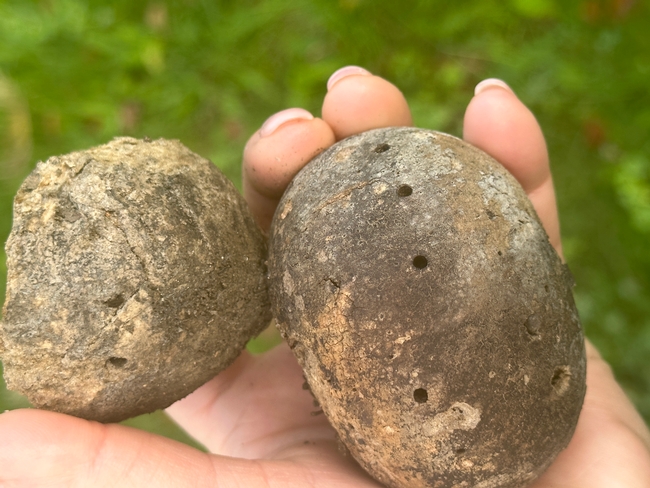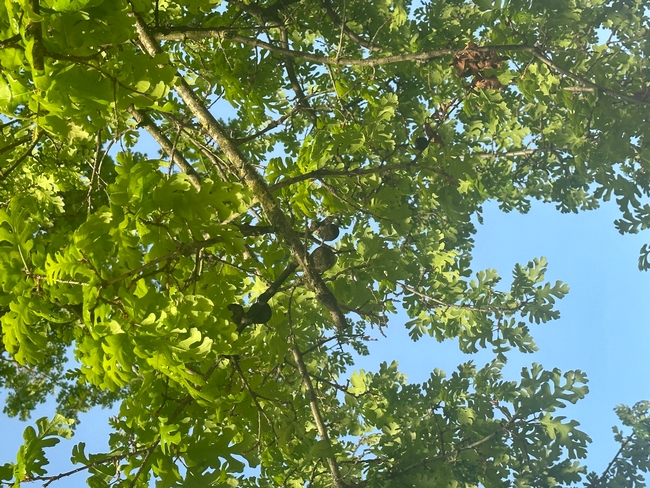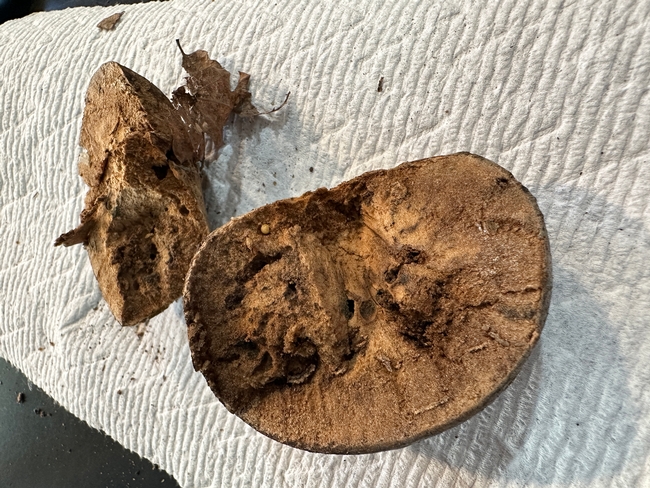I used to wonder why hard apples were growing on some of my oak trees. Then I learned they were not apples but nests for Andricus quercuscalifornicus, a tiny wasp that builds these galls as a nest for raising their young.
The galls occur mostly on white oaks such as our common Valley Oak (Quercus lobata). There are many varieties of wasps throughout the country and they build nests of different shapes and designs.
The adult wasp deposits chemicals within the leaf buds of the oak tree as they are forming. The chemicals cause the gall to form from plant tissue. The wasp lays its eggs inside. If you cut open a gall once it has matured, you can see the small paths the wasp has used.
The galls do not harm the trees. In the past the galls were sometimes used for medicinal purposes, as treatments for diarrhea, eye washes and cuts and burns. They were also fed to livestock and used for clothing dye and ink. Some people want them removed for appearance reasons, but I never bother to remove mine. It's interesting to watch nature in action before your eyes.
The size, shape and color of the gall depends on the wasp that created it. The gall we see most often in our area is green.
The wasp itself is important to the insect world. It is prey for other insects, including an East Coast butterfly.
I have only seen the wasps a few times. They are tiny, about ¼ inch long. They do not feed at all during their brief week-long life; their main purpose is to produce the next generation. They find a place to plant their eggs, and when the larvae hatch, they produce the chemicals that create the galls.
Many types of wasps use this method to reproduce. They typically lay eggs in spring or early summer, and the larvae spend the summer building the gall and feeding. They mature and leave the gall in the fall.
I recently had an oak tree trimmed of lower branches, which were covered with galls. I took one the size of a small lemon and counted 18 holes created when the wasps left the gall. The average is about 12. If you cut open the gall, you can easily see the wasp trails.
Many ancient writings were done with ink made from pulverized galls mixed with other substances and water. Pliny the Elder used ink from oak galls.
One word of warning: Although the oak gall resembles an apple, it is definitely not edible. Just admire this clever adaptation of nature.
Workshop: Join UC Master Gardeners of Napa County for a “Garden Design” workshop on Saturday, April 29, from 10 a.m. to noon at Las Flores Learning Garden, Las Flores Community Center, 4300 Linda Vista Avenue, Napa. Dress warmly and be prepared for outdoor activities. Space is limited; register at https://ucanr.edu/2023lflg_aprilgardendesign.
Workshop: Join UC Master Gardeners of Napa County for a “Worm Composting” workshop on Saturday, April 29, from noon to 2 pm, at UCCE Cooperative Extension, 1710 Soscol Avenue #4, Napa. Attendees receive a free worm compost toolkit, including the worms. You will set it up with the UC Master Gardeners and take it home. Space is limited; register at https://docs.google.com/forms/d/e/1FAIpQLSeDANb8AyTVoBtLmC4EtiZleYws9xCo_vKPWEQarUtwu2ynpQ/viewform.
Workshop: Join UC Master Gardeners of Napa County for a talk on “How to Design a Fabulous Container Garden” on Wednesday, May 3, from 11:30 am to 12:30 pm, at American Canyon Adult Activity Center, 2185 Elliott Drive, American Canyon. To register, visit https://secure.rec1.com/CA/american-canyon-ca/catalog. Select “Active Adults 50+ Classes,” then scroll down to “Gardening.”
Library Talk: Join UC Master Gardeners of Napa County and Napa Library for a free talk on “Resilient Landscaping for Fire and Drought” on Thursday, May 4, from 6 pm to 7 pm, at the Napa Library 580 Coombs Street, Napa. Register at:
https://ucanr.edu/2023MayFire&DroughtLibraryTalk
Help Desk: The Master Gardener Help Desk is available to answer your garden questions on Mondays and Fridays from 10 a.m. until 1 p.m at the University of California Cooperative Extension Office, 1710 Soscol Avenue, Suite 4, Napa. Or sSend your questions to mastergardeners@countyofnapa.org. Include your name, address, phone number and a brief description of the problem. For best results, attach a photo of the plant. You may also leave a voicemail message with the same information at 707-253-4143.


